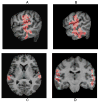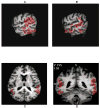Dopamine D2 receptor levels in striatum, thalamus, substantia nigra, limbic regions, and cortex in schizophrenic subjects
- PMID: 19251247
- PMCID: PMC2951678
- DOI: 10.1016/j.biopsych.2008.12.029
Dopamine D2 receptor levels in striatum, thalamus, substantia nigra, limbic regions, and cortex in schizophrenic subjects
Abstract
Background: Studies in schizophrenic patients have reported dopaminergic abnormalities in striatum, substantia nigra, thalamus, anterior cingulate, hippocampus, and cortex that have been related to positive symptoms and cognitive impairments.
Methods: [(18)F]fallypride positron emission tomography studies were performed in off-medication or never-medicated schizophrenic subjects (n = 11, 6 men, 5 women; mean age of 30.5 +/- 8.0 [SD] years; 4 drug-naive) and age-matched healthy subjects (n = 11, 5 men, 6 women, mean age of 31.6 +/- 9.2 [SD]) to examine dopamine D(2) receptor (DA D(2)r) levels in the caudate, putamen, ventral striatum, medial thalamus, posterior thalamus, substantia nigra, amygdala, temporal cortex, anterior cingulate, and hippocampus.
Results: In schizophrenic subjects, increased DA D(2)r levels were seen in the substantia nigra bilaterally; decreased levels were seen in the left medial thalamus. Correlations of symptoms with ROI data demonstrated a significant correlation of disorganized thinking/nonparanoid delusions with the right temporal cortex ROI (r = .94, p = .0001), which remained significant after correction for multiple comparisons (p < .03). Correlations of symptoms with parametric images of DA D(2)r levels revealed no significant clusters of correlations with negative symptoms but significant clusters of positive correlations of total positive symptoms, delusions and bizarre behavior with the lateral and anterior temporal cortex, and hallucinations with the left ventral striatum.
Conclusions: The results of this study demonstrate abnormal DA D(2)r-mediated neurotransmission in the substantia nigra consistent with nigral dysfunction in schizophrenia and suggest that both temporal cortical and ventral striatal DA D(2)r mediate positive symptoms.
Conflict of interest statement
Dr. Kessler has investigator initiated research support from Janssen, consults with and is a shareholder in PharmorRx. Dr. Herbert Meltzer has been a consultant to and received grants from Abbot, ACADIA, ARYx, BioLine Rx, Bristol Myers Squibb, Cephalon, Eli Lilly, Janssen, Litmus Molecular Design, Memory, Minster, and Pfizer. Dr Meltzer has been a consultant to Astellas, Glaxo Smith Kline, Lundbeck, Merck, Otsuka, Roche, and Solvay, and has received grants from Dainippon Sumitomo, Sepreacor, and SK Pharma. Drs. Woodward, Riccardi, Dawant, and Zald, Mr. Ansari and Li, and Ms. Anderson have no biomedical financial interests or potential conflicts of interest.
Figures




References
-
- Davis KL, Kahn RS, Ko G, Davidson M. Dopamine in Schizophrenia: A Review and Reconceptualization. Am J Psychiatr. 1991;148:1474–86. - PubMed
-
- Weinberger DR, Egan MF, Bertolino A, Callicott JH, Mattay VS, Lipska BK, Berman KF, Goldberg TE. Prefrontal Neurons and the Genetics of Schizophrenia. Biol Psychiatry. 2001;50:825–844. - PubMed
-
- Goldman-Rakic PS. The Relevance of the Dopamine-D1 Receptor in the Cognitive Symptoms of Schizophrenia. Neuropsychopharmacology. 1999;21 6:S171–S177.
-
- Bilder RM, Reiter G, Bates J, Lencz T, Szeszko P, Goldman RS, Robinson D, Lieberman JA, Kane JM. Cognitive development in schizophrenia: follow-back from the first episode. J Clin Exp Neuropsychol. 2006;28(2):270–82. - PubMed
Publication types
MeSH terms
Substances
Grants and funding
LinkOut - more resources
Full Text Sources
Medical

